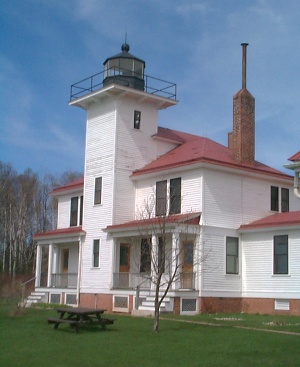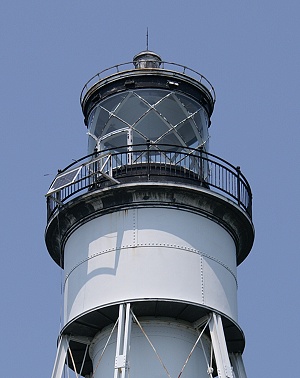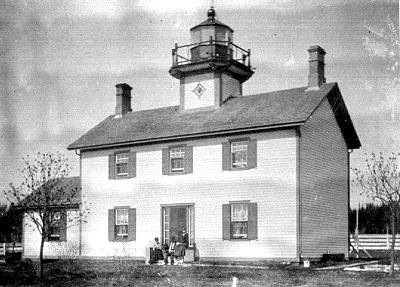| |
Lighthouses of the Apostle Islands
|
Originally published
in
Lake Superior magazine
August/ September, 2002 |
Old Michigan Island Lighthouse |
|
"The largest and finest collection of lighthouses in the United
States."
That’s the judgment of historian F. Ross Holland on the light stations
of Lake Superior’s Apostle Islands: six island outposts, with eight towers
between them, in one of the world’s most beautiful settings. There’s the
elegant brick tower on Outer Island’s bluffs, and the tall cast-iron cylinder
atop the Devils Island sea caves. A stately mansion on Raspberry, two
towers each on Long and Michigan Islands, and a brownstone gem on Sand
Island.

Raspberry
Island Lighthouse |
For more than a century, these light stations were home to men and women
who endured the privations of island life in order to provide mariners
with reliable beacons to guide them on the waters of Lake Superior. The
keepers and their families are gone now, replaced by solar panels and
automatic bulb-changers, but visitors can tour their dwellings and climb
the towers, preserved today within a national park.
The story of these lighthouses mirrors the development of commerce on
Lake Superior. When the Soo locks opened in 1855, Federal authorities
realized that increased shipping would need lights for guidance. Among
the highest priorities for a beacon was the harbor of LaPointe, on Madeline
Island. The only town of any size on the western end of the lake, the
old fur post was a natural destination.
There’d been quite a bit of discussion about exactly where to put the
LaPointe beacon. Since the port was on the landward side of Madeline Island,
it would not have made much sense to put the lighthouse at the harbor
entrance. Such a light would not be visible until ships were right in
front of it, well past all the surrounding hazards. Much better, everyone
agreed, to put the light across the channel on Long Island, where it would
be visible well out on the open lake.
Everyone agreed, that is, except Abraham Smolk, the mid-level Lighthouse
Service official assigned to supervise construction in the region. Smolk
arrived at LaPointe, took a quick look around, and impulsively decided
that it would be best to place the new lighthouse on Michigan Island,
seventeen miles north of the specified site. The contractor protested—
erecting a tower on the Michigan Island clifftop would be far more costly
than building on Long Island’s flat sand.
But Smolk held firm, and the Apostles’ first lighthouse went up on Michigan
Island: a small stone tower, with keeper’s dwelling attached. Construction
was finished in October, 1856, and the lighthouse entered service the
following June. Just about immediately, everyone realized it was in the
wrong place. Dangerous shoals lay to the north of Michigan Island, but
the low tower at the island’s south end gave seamen no warning of their
proximity. Abraham Smolk had no business changing the agreed-on plans,
his superiors thundered. Repudiating his instructions, they ordered the
builders to go back and put up the lighthouse on Long Island, at their
own expense.
The contractors protested, but to no avail. They were stuck.
On the brink of bankruptcy, they went back to Long Island and threw together
a wooden lighthouse, as quickly and as cheaply as they could. This lighthouse
served its purpose well enough for nearly forty years; then in 1897, with
traffic booming at the nearby port of Ashland, the government replaced
it with a pair of cast-iron towers spaced nearly a mile apart. One of
these, the “New LaPointe” tower, remains in service today, while the other,
at the island’s tip, stands empty now, supplanted by a plain steel cylinder
in 1986.
And the misbegotten lighthouse on Michigan Island? Stripped of
its fittings, the building sat vacant for twelve years. Then, as traffic
continued to increase, the Lighthouse Service decided an extra lighthouse
might be useful after all. Workers repaired the effects of a decade’s
neglect, and the Michigan Island light resumed operation in 1869.

New Michigan
Island Lighthouse
|
The little lighthouse was never completely satisfactory as a guide for
shipping, though. Abraham Smolk’s rash decision continued to haunt the
Lighthouse Service. Several ships ran aground off Michigan Island, and
for years, maritime interests pressed the government to remedy the problem.
Finally, in 1929, the Lighthouse Service erected a second tower on Michigan
Island, nearly twice the height of the original. (right)
The “new” Michigan tower was not very new at all, though; the tall cast-iron
tube had been built longside Pennsylvania’s Delaware River in 1880. When
dredging straightened the course of the Delaware, the government found
itself with a spare lighthouse it could send to Lake Superior. Today,
two towers stand side-by-side on the island: one still in active service,
its older companion empty of all but memories.
By 1862, with lighthouses at Long and Michigan Islands, the eastern
approach to the ports of Chequamegon Bay was well-marked. In that year,
the Lighthouse Service installed a beacon on Raspberry Island to mark
the western route. Like the LaPointe light, it was a “schoolhouse-style”
structure, a wood building with a lantern room mounted on top.
This two-bedroom house may have been satisfactory for a single keeper
and his family, but over the years the need for additional room became
acute. In 1887, keeper Francis Jacker decided to leave his large family
at their mainland home. He soon found that tending the light without help
was exhausting. In a letter, he worried prophetically, “In case of an
emergency, no assistance is available on the island.”

Raspberry
Island Lighthouse, circa 1900 |
In September of that year, Jacker’s fears were realized while trying
to move the station’s sailboat to shelter in the face of a rising gale.
Blown off-course, he was driven ashore on uninhabited Oak Island, and
his boat wrecked by the surf. With neither assistant keeper nor family
on Raspberry Island to notice his absence, he faced certain death by starvation
or exposure. Providentially, after an ordeal of three days, his wife decided
to pay him an impromptu visit at Raspberry. Dismayed to find the lighthouse
empty, she organized a successful search.
In the aftermath of that incident, the Lighthouse Service authorized
an assistant keeper’s position at Raspberry Island. At the turn of the
twentieth century, the island’s population increased again, when the agency
added a fog signal to the station’s arsenal. State-of-the-art foghorns
were powered by steam in those days, and a second assistant keeper was
hired to help with firing the boiler and tending the machinery. The original
lighthouse, bursting at its seams, was remodeled to provide separate apartments
for each keeper. Some modern observers comment that the result looks more
like a country manor than a lighthouse.
Continue to Part Two
|
|